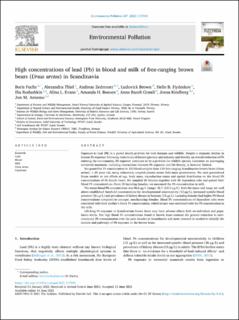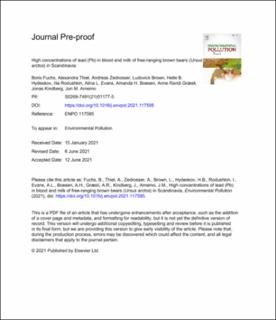| dc.contributor.author | Fuchs, Boris | |
| dc.contributor.author | Thiel, Alexandra | |
| dc.contributor.author | Zedrosser, Andreas | |
| dc.contributor.author | Brown, Ludovick | |
| dc.contributor.author | Hydeskov, Helle Bernstorf | |
| dc.contributor.author | Rodushkin, Ilia | |
| dc.contributor.author | Evans, Alina | |
| dc.contributor.author | Boesen, Amanda Høyer | |
| dc.contributor.author | Græsli, Anne Randi | |
| dc.contributor.author | Kindberg, Jonas | |
| dc.contributor.author | Arnemo, Jon Martin | |
| dc.date.accessioned | 2021-11-25T08:45:17Z | |
| dc.date.available | 2021-11-25T08:45:17Z | |
| dc.date.created | 2021-06-18T09:06:16Z | |
| dc.date.issued | 2021 | |
| dc.identifier.citation | Environmental Pollution (1987). 2021, 287 . | en_US |
| dc.identifier.issn | 0269-7491 | |
| dc.identifier.uri | https://hdl.handle.net/11250/2831407 | |
| dc.description.abstract | Exposure to lead (Pb) is a global health problem for both humans and wildlife. Despite a dramatic decline in human Pb exposure following restrictions of leaded gasoline and industry and thereby an overall reduction of Pb entering the environment, Pb exposure continues to be a problem for wildlife species. Literature on scavenging terrestrial mammals, including interactions between Pb exposure and life history, is however limited.
We quantified Pb concentration in 153 blood samples from 110 free-ranging Scandinavian brown bears (Ursus arctos), 1–25 years old, using inductively coupled plasma sector field mass spectrometry. We used generalized linear models to test effects of age, body mass, reproduction status and spatial distribution on the blood Pb concentrations of 56 female bears. We sampled 28 females together with 56 dependent cubs and paired their blood Pb concentrations. From 20 lactating females, we measured the Pb concentration in milk.
The mean blood Pb concentration was 96.6 μg/L (range: 38.7–220.5 μg/L). Both the mean and range are well above established threshold concentrations for developmental neurotoxicity (12 μg/L), increased systolic blood pressure (36 μg/L) and prevalence of kidney disease in humans (15 μg/L). Lactating females had higher Pb blood concentrations compared to younger, non-lactating females. Blood Pb concentrations of dependent cubs were correlated with their mother's blood Pb concentration, which in turn was correlated with the Pb concentration in the milk.
Life-long Pb exposure in Scandinavian brown bears may have adverse effects both on individual and population levels. The high blood Pb concentrations found in brown bears contrast the general reduction in environmental Pb contamination over the past decades in Scandinavia and more research is needed to identify the sources and pathways of Pb exposure in the brown bears. | en_US |
| dc.language.iso | eng | en_US |
| dc.rights | Navngivelse 4.0 Internasjonal | * |
| dc.rights.uri | http://creativecommons.org/licenses/by/4.0/deed.no | * |
| dc.title | High concentrations of lead (Pb) in blood and milk of free-ranging brown bears (Ursus arctos) in Scandinavia | en_US |
| dc.type | Peer reviewed | en_US |
| dc.type | Journal article | en_US |
| dc.description.version | acceptedVersion | en_US |
| dc.description.version | publishedVersion | en_US |
| dc.subject.nsi | VDP::Zoologiske og botaniske fag: 480 | en_US |
| dc.subject.nsi | VDP::Zoology and botany: 480 | en_US |
| dc.source.pagenumber | 0 | en_US |
| dc.source.volume | 287 | en_US |
| dc.source.journal | Environmental Pollution (1987) | en_US |
| dc.identifier.doi | 10.1016/j.envpol.2021.117595 | |
| dc.identifier.cristin | 1916642 | |
| dc.relation.project | Andre: Norwegian Environment Agency | en_US |
| dc.relation.project | Norges forskningsråd: xxxxxx | en_US |
| dc.relation.project | Andre: Swedish Environmental Protection Agencies | en_US |
| cristin.ispublished | true | |
| cristin.fulltext | postprint | |
| cristin.fulltext | original | |
| cristin.qualitycode | 1 | |


